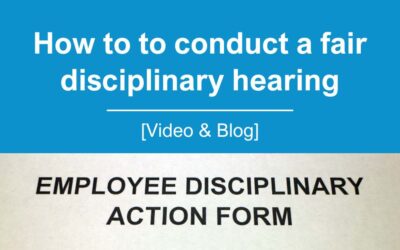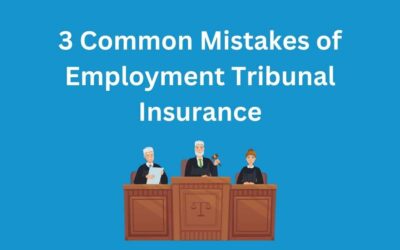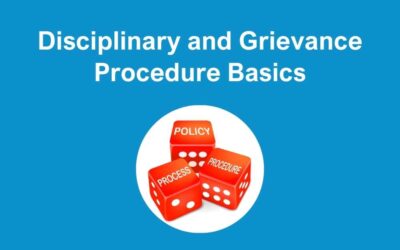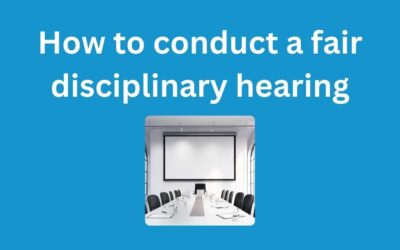In a recent blog article, we looked at how to conduct a fair disciplinary meeting. Below we follow up on this article by providing you with some key steps to take when deciding an outcome of disciplinary hearing.
If you followed our previous advice on how to conduct disciplinaries in the workplace, you’re well on your way to carrying out a fair and reasonable procedure. You will also be closer to helping safeguard your business against the risk of tribunals and the costs they can bring.
In this article, we set out some key steps to help you confidently reach a fair outcome decision and write a disciplinary letter.
The Adjournment
Once you reach the adjournment of the meeting this is your opportunity to take some time to review and consider all the information you have about the case in question. This includes whatever your employee may have just told you in the preceding disciplinary procedure.
Follow-up
Just like the outset of the meeting, an investigation is key to make sure you get the right outcome of disciplinary hearing. Your employee may have just given you some new information or a version of events that you weren’t previously aware of. It is, therefore, important to give this the due consideration it deserves. Failing to do this could undermine all the good work you’ve done up to this point.
To follow up on new information, you should speak to witnesses, fellow colleagues, other managers or reviewing paperwork, files, or maybe even CCTV footage. Whatever you feel you need to review, ensure that you keep a record of any follow-up investigations you conduct. You should then share this with your employee.
Sometimes this follow-up investigation can take a matter of minutes during an adjournment. However, for more detailed investigations or complex cases you may need to adjourn the meeting for longer to allow the investigation to take place. If you do need a longer adjournment, it’s important to maintain contact with your employee so that they understand where things are. Don’t forget this may be a stressful time for them, especially for more serious disciplinary allegations.
In this follow-up investigation, you are seeking to put yourself in a good position to be able to accept the response or mitigation provided by your employee, or reject it, and ultimately make the right outcome decision for that employee and for your business.
Although we’ve emphasised the importance of follow-up investigations, this is not always necessary. Particularly if no new information comes to light. You should still, however, take some time at the meeting adjournment to consider the case and your outcome decision. This can help to demonstrate that the outcome decision of disciplinary hearing was not pre-conceived.
Making the decision
Something I regularly say to clients to visualise the case as a set of weighing scales:
On the business’ side, you have all the “bad” things that you have alleged your employee has done, which are weighing the scales down. The other side of the scales, your employee’s side is empty.
Now think about what your employee has said to you during the disciplinary meeting. Is there anything they have said that you can place on their side of the scales to tip that balance? Is there something that offsets the bad things and puts the case in your employee’s favour?
If you find yourself struggling to reach a decision, or are unsure of a decision, it is most likely because you don’t have enough information. In this instance, you should reconvene the meeting and ask your employee some more questions, or carry out more investigation.
Rationale
It is important to realise that it’s not just about what the outcome of disciplinary hearing is. Even more importantly it’s the rationale that underpins your decision.
You may choose to issue your employee with a formal warning. Although, you will need to evidence and explain why you made this decision.
When thinking about your rationale it can be helpful to think about why you have chosen to not accept the employee’s response, or why is it that what they have done is a bad thing and cannot be tolerated by your business?
Reasonable belief
A common misunderstanding we come across with clients is that in order to discipline their employees they have to be able to prove that something did or did not happen. In employment law terms this is not true, as this level of proof is not required. Instead, it is important to be able to form what is referred to as ‘reasonable belief’.
When considering the question of reasonable belief, it can be helpful to imagine asking 10 people on the street. Would these random 10 people reach the same outcome decision as you? Doing this can help you test whether your decision is reasonable to believe.
Decision Options
As you may recall in part one of this ‘how to’ guide, we advised that in the invite letter sent to your employee you should include details about what “the potential consequences or potential outcome of the meeting” might be. Therefore your outcome of disciplinary hearing is normally limited to a maximum of whatever you stated here.
Below is a summary of potential outcomes at the various stages of the disciplinary process:
- Verbal warning (if your policy includes this – our advice is not to have this stage in your policy)
- Written Warning
- Final Written Warning
- Dismissal
- Summary Dismissal
- Some other action-stopping short of dismissal – e.g. demotion/removal of duties
- No formal action
It is helpful to remember that the fundamental purpose of issuing a warning is to seek to correct, improve and/or cease the ‘bad thing’ that your employee has done. If issuing this is not going to correct the problem, you may need to consider whether this it is the right thing to do.
Another important factor to consider is consistency. If you discipline an employee for a particular offence, then you should apply appropriate consistency if another employee commits the same offence. Having said that, there may be a genuine reason to make an exception. It’s important to be able to recognise when both these things are appropriate. This way you are not diluting your businesses principles or acting unfairly towards your employees.
Here at the HR Booth, we have a wealth of experience in supporting managers and businesses to make the right disciplinary outcome decision at whatever level is appropriate.
Confirming your decision
When you have reached an outcome of disciplinary hearing and have a clear rationale for your decision, you need to confirm this to your employee. This can be done by reconvening the meeting and delivering your decision in person.
Whether or not you choose to do this, you must confirm your outcome decision in writing. You must also provide a copy of this to your employee, within a reasonable time following the disciplinary meeting.
The Outcome Letter
In your outcome letter, you should refer to what the original disciplinary allegations. This will ensure your invite and disciplinary outcome letter mirror each other.
Your outcome letter should ideally include:
- A summary of the original allegations
- A summary of what your employee said in response to the allegations
- Details of your consideration of the employee’s response
- What the outcome of disciplinary hearing is
- Your rationale
- The length of any disciplinary warning issued
- What happens next (see expectations below)
- The opportunity to appeal
This might seem like a lot to cover. However, a useful principle to remember when writing an outcome letter is that the level of detail should be equivalent to the severity of the case in question. The more complex or high risk the case, the more detail should go into the outcome letter.
Setting Expectations
As referred to in the list above, it is important that if you issue a formal disciplinary warning to your employee, you set some expectations as to what you require of them going forward.
Your employee needs to be clear that whatever the ‘bad thing’ was cannot happen again. They also need to know what the consequences may be if it does happen again e.g. a further warning at the next stage in the disciplinary process, or dismissal.
Your employee should also be clear that during the period of any warning, any further issues of conduct (e.g. breach of conduct, poor performance, poor attendance or any other potential disciplinary issue) may lead to disciplinary action at the next stage of the process, since disciplinary warnings aggregate.
You should ensure that you communicate this clearly. It is not about threatening your employee but setting appropriate expectations with them.
The Right to Appeal
Wherever you have an outcome of disciplinary hearing, your employee should always be offered the opportunity to appeal your decision.
In providing a right of appeal you should state:
- That their appeal should be set out in writing
- That their appeal letter should clearly set out their grounds for appeal
- Where and who to send their appeal letter to
- Any timescales relevant to making an appeal (normally within 7 days of receipt of the disciplinary outcome letter)
When thinking about who should hear an appeal this should usually be another manager or Director in your business. Someone who is more senior or equivalent to the original disciplinary decision maker, and has not already been involved in the case. We recognise that not all businesses we support have someone else to act as an Appeal Hearer. We can help with providing you with an independent Appeal Hearer from the HR Booth.
Finally, if you have followed our guidance on how to conduct a fair disciplinary meeting and making a fair outcome decision, then you are dramatically reducing the risk of exposing your business to employment tribunals.
It is important to remember these guiding principles at all stages of the process, even the early stages. The early stages are the foundations for any later stages of disciplinary. Failure to carry out a fair and reasonable procedure, and make a fair decision can make what could be a straightforward dismissal, high risk or untenable, due to an earlier procedural flaw.






